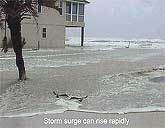What Is The Most Damaging Hazard From A Hurricane?
 The greatest potential for loss of life and property related to a hurricane is from the storm surge—water pushed ashore by the force of the winds accompanying a hurricane. Although hurricanes are usually described in terms of their wind speeds, historically storm-surge flooding has claimed more victims (nine of 10) than wind. During the past 30 years, however, inland flooding has caused most hurricane-related deaths. Specifically, storm surge forms when hurricane force winds push water up into a mound. When a storm is at sea, the water easily flows away. However, as a hurricane crosses the continental shelf and nears land, the water piles up creating a storm surge, which can inundate coastal areas. Generally, for a hurricane that crosses perpendicular to the coastline the highest part of the storm surge will be to the right of the eye where the strongest winds eventually blow 'on shore.'
The greatest potential for loss of life and property related to a hurricane is from the storm surge—water pushed ashore by the force of the winds accompanying a hurricane. Although hurricanes are usually described in terms of their wind speeds, historically storm-surge flooding has claimed more victims (nine of 10) than wind. During the past 30 years, however, inland flooding has caused most hurricane-related deaths. Specifically, storm surge forms when hurricane force winds push water up into a mound. When a storm is at sea, the water easily flows away. However, as a hurricane crosses the continental shelf and nears land, the water piles up creating a storm surge, which can inundate coastal areas. Generally, for a hurricane that crosses perpendicular to the coastline the highest part of the storm surge will be to the right of the eye where the strongest winds eventually blow 'on shore.'
The height of the storm surge depends on the wind speed. The stronger the wind speed, the higher the storm surge. In powerful Category 4 and 5 hurricanes, storm surge maximums of 20 to 25 feet are possible for many locations along the U.S. Gulf and Atlantic shorelines. This surge also combines with the normal astronomical tides to create the hurricane 'storm tide,' which can further increase the water level. Lastly, at the shore line, 5 to 10-foot high wind driven waves are often superimposed on top of this 'storm tide.' These storm surge components can cause severe flooding and damage in coastal areas—often many miles inland depending on the terrain—particularly when they coincide with normal high tide. Storm surge normally does not arrive as a 'wall of water,' but instead more like a quickly rising VERY high tide.
Its destructive forces are immense. Water weighs an impressive 64 pounds per cubic foot and ocean waves can be as powerful as battering rams. Currents associated with storm surge also cause extensive damage. As the water begins rising in advance of the storm, high water and pounding waves create currents, eroding beaches and carrying away sand under sea walls, buildings and roads. When Hurricane Eloise hit the Florida Panhandle in September of 1975, it carried away an average of 45 cubic yards of sand for each yard of beach front along nine miles of the coast. Even buildings that can withstand hurricane force winds have little chance if their foundations are weakened and fail due to eroding sand under and around them. Likewise, boats are often ripped from their moorings; trees and utility poles are uprooted. Worse yet, the destruction accelerates when the storm surge—now laden with large debris loosened by the storm—reaches further inland.
About the Author
NOAA National Oceanic and Atmospheric Administration
 The National Oceanic and Atmospheric Administration is an American scientific agency within the United States Department of Commerce that focuses on the conditions of the oceans, major waterways, and the atmosphere.
The National Oceanic and Atmospheric Administration is an American scientific agency within the United States Department of Commerce that focuses on the conditions of the oceans, major waterways, and the atmosphere.


